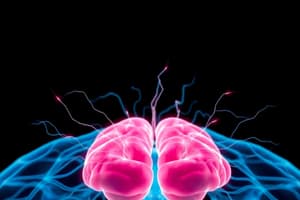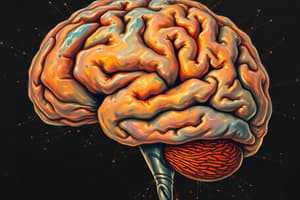Podcast
Questions and Answers
What term describes the ability of neurons to adapt and change in response to different stimuli?
What term describes the ability of neurons to adapt and change in response to different stimuli?
- Neuroplasticity (correct)
- Habituation
- Neurodevelopment
- Synaptic Efficiency
Which of the following is NOT an example of neuroplasticity?
Which of the following is NOT an example of neuroplasticity?
- Motor learning in adults
- Cellular recovery after injury
- Static structural changes without function (correct)
- Habituation and sensitization
Which process illustrates the principle 'neurons that fire together wire together'?
Which process illustrates the principle 'neurons that fire together wire together'?
- Neurodevelopment during childhood
- Recovery after brain injury
- Weakly activated synapses losing their connection
- Learning through new information (correct)
What changes can occur in the nervous system as a result of neuroplasticity?
What changes can occur in the nervous system as a result of neuroplasticity?
Which of the following best describes Hebb's hypothesis regarding synaptic plasticity?
Which of the following best describes Hebb's hypothesis regarding synaptic plasticity?
What is the primary focus of the course DPT 452 Functional Neuroscience?
What is the primary focus of the course DPT 452 Functional Neuroscience?
Which principle is closely related to recovery of function in motor learning?
Which principle is closely related to recovery of function in motor learning?
What is NOT a component of optimizing motor learning during treatment sessions?
What is NOT a component of optimizing motor learning during treatment sessions?
Which aspect of neuroplasticity is highlighted in the definition provided by Leonard (1998)?
Which aspect of neuroplasticity is highlighted in the definition provided by Leonard (1998)?
What do 'implicit and explicit processes' refer to in the context of motor learning?
What do 'implicit and explicit processes' refer to in the context of motor learning?
What is one of the key outcomes of long-term potentiation (LTP)?
What is one of the key outcomes of long-term potentiation (LTP)?
What role does synaptic competition play in neural connectivity?
What role does synaptic competition play in neural connectivity?
Which factor is NOT important in associative learning?
Which factor is NOT important in associative learning?
How does procedural learning differ from other types of learning?
How does procedural learning differ from other types of learning?
What is a crucial aspect of synaptic stabilization?
What is a crucial aspect of synaptic stabilization?
What process occurs when repeated exposure to a stimulus results in a decreased response?
What process occurs when repeated exposure to a stimulus results in a decreased response?
Which concept relates to how well skills learned in one context transfer to another?
Which concept relates to how well skills learned in one context transfer to another?
What term describes a set of internal processes associated with practice leading to lasting change in skilled behavior?
What term describes a set of internal processes associated with practice leading to lasting change in skilled behavior?
What characterizes explicit learning in the context of motor skills?
What characterizes explicit learning in the context of motor skills?
Which of the following best describes implicit learning?
Which of the following best describes implicit learning?
According to Schmidt's Schema Theory, what is stored in short term memory after a movement?
According to Schmidt's Schema Theory, what is stored in short term memory after a movement?
What is the main goal of ecological theory in motor learning?
What is the main goal of ecological theory in motor learning?
What is an essential aspect of variable practice in both motor learning theories?
What is an essential aspect of variable practice in both motor learning theories?
What does knowledge of performance (KP) refer to in motor learning?
What does knowledge of performance (KP) refer to in motor learning?
How do explicit and implicit systems interact in motor learning?
How do explicit and implicit systems interact in motor learning?
Which component is NOT part of Schmidt's schema theory?
Which component is NOT part of Schmidt's schema theory?
What distinguishes performance from learning?
What distinguishes performance from learning?
Which of the following best defines 'retention' in motor learning?
Which of the following best defines 'retention' in motor learning?
What role does attention play in the encoding process?
What role does attention play in the encoding process?
Which process involves structural changes in neurons?
Which process involves structural changes in neurons?
What best describes transfer in motor learning?
What best describes transfer in motor learning?
Which two types of learning are identified in the content?
Which two types of learning are identified in the content?
How is performance characterized during early trials of a learning process?
How is performance characterized during early trials of a learning process?
Which part of the brain is primarily involved in procedural memory?
Which part of the brain is primarily involved in procedural memory?
What is a key characteristic of implicit learning?
What is a key characteristic of implicit learning?
What is the relationship between sensory processing and memory consolidation?
What is the relationship between sensory processing and memory consolidation?
Flashcards
Neuroplasticity
Neuroplasticity
The ability of the nervous system to change and adapt in response to experience.
Motor Learning
Motor Learning
The process of acquiring and refining motor skills through practice and experience.
Implicit Learning
Implicit Learning
Learning that occurs without conscious awareness or intention.
Explicit Learning
Explicit Learning
Signup and view all the flashcards
Task-Oriented Approach
Task-Oriented Approach
Signup and view all the flashcards
Plasticity
Plasticity
Signup and view all the flashcards
Habituation
Habituation
Signup and view all the flashcards
Sensitization
Sensitization
Signup and view all the flashcards
Hebb's Rule
Hebb's Rule
Signup and view all the flashcards
Synaptic Plasticity
Synaptic Plasticity
Signup and view all the flashcards
LTP
LTP
Signup and view all the flashcards
LTD
LTD
Signup and view all the flashcards
Synaptic Segregation
Synaptic Segregation
Signup and view all the flashcards
Synaptic Convergence
Synaptic Convergence
Signup and view all the flashcards
Synaptic Competition
Synaptic Competition
Signup and view all the flashcards
Procedural Learning
Procedural Learning
Signup and view all the flashcards
Motor Adaptation
Motor Adaptation
Signup and view all the flashcards
What's the difference between explicit and implicit learning?
What's the difference between explicit and implicit learning?
Signup and view all the flashcards
What are the two names for explicit learning?
What are the two names for explicit learning?
Signup and view all the flashcards
Why do we use explicit learning in therapy?
Why do we use explicit learning in therapy?
Signup and view all the flashcards
Implicit learning is like...
Implicit learning is like...
Signup and view all the flashcards
Schmidt Schema Theory
Schmidt Schema Theory
Signup and view all the flashcards
What does variable practice do in Schmidt's theory?
What does variable practice do in Schmidt's theory?
Signup and view all the flashcards
Ecological Theory: How does learning occur?
Ecological Theory: How does learning occur?
Signup and view all the flashcards
What are regulatory cues?
What are regulatory cues?
Signup and view all the flashcards
Performance
Performance
Signup and view all the flashcards
Retention
Retention
Signup and view all the flashcards
Transfer
Transfer
Signup and view all the flashcards
What is learning?
What is learning?
Signup and view all the flashcards
Performance versus Learning
Performance versus Learning
Signup and view all the flashcards
What does a performance curve measure?
What does a performance curve measure?
Signup and view all the flashcards
Encoding
Encoding
Signup and view all the flashcards
Consolidation
Consolidation
Signup and view all the flashcards
Study Notes
Course Information
- Course Title: DPT 452 Functional Neuroscience
- Course Term: Fall 2024
- Instructor: Anne K. Galgon PT PhD NCS
- Key Topics: motor learning/neuroplasticity, neural mechanisms of postural control, neural mechanisms of locomotion, motor control and upper extremity (UE) movement
Course Schedule
- Today and Monday (11/18): motor learning/neuroplasticity
- Wednesday (11/20): Neural mechanisms of postural control; Quiz 3 (motor control and UE)
- Thanksgiving break
- Monday (12/1) after Thanksgiving: Motor learning lab (last assignment)
- 11/15-12/30 after Thanksgiving: Neural mechanisms of locomotion
- Wednesday (12/4): Review class; Quiz 4 (motor learning)
- Final Exam (12/11)
Course Objectives
- Students will understand the principles of neuroplasticity related to motor learning.
- Students will identify motor learning principles and apply them to improve motor skill performance.
- Students will learn and apply the components for optimizing motor learning during treatment sessions.
- Students will define functional recovery and how motor learning relates to it.
Topics
- Physiological Basis for Learning
- Neuroplasticity (SC&W pp 80-90)
- Motor Learning (Definitions/Terms, Implicit/Explicit processes, Theories)
- Task-oriented approach
- Stages of Learning
- Motor Learning Practice Parameters
Neuroplasticity
- The nervous system is not static; it is continuously reshaped by environmental needs and demands.
- Neuroplasticity is present throughout life, but its degree doesn't match changes in young animals.
- Neuroplasticity occurs during neurodevelopment (childhood), learning (motor learning in adults), and recovery after injury (brain or musculoskeletal).
- Neurons change their function, chemical profile, or structure over time.
- Examples include habituation/sensitization, learning/memory, and cellular recovery after injury.
- Neuroplastic changes are seen in the parallel continuum of learning (short-term and long-term).
Definition of Neuroplasticity
- A general term for the nervous system's ability to adapt and change.
- Includes changes in physiology (nerve thresholds, conduction velocity, and synaptic efficiency), anatomical morphology (structure and connectivity), and behavior (learning/recovery of function).
Rules of Synaptic Plasticity (Hebb's Hypotheses)
- When a presynaptic axon is active, and the postsynaptic neuron is strongly activated by other inputs—the presynaptic axon is strengthened. “Neurons that fire together, wire together.”
- When the presynaptic axon is active, and the postsynaptic neuron is weakly activated by other inputs—the synapse is weakened. “Neurons that fire out of sync, lose their link.”
Activity-Dependent Synaptic Plasticity
- Long-term potentiation (LTP) and long-term depression (LTD) are changes in the effectiveness of presynaptic neurons and excitability of postsynaptic neurons.
- Synaptogenesis is the creation of new connections.
Experience-Dependent Plasticity
- Motor skill acquisition leads to neuronal-level changes (e.g., greater amounts of cortex, increases in synapses, changes in dendritic spine growth, changes in axon arborisation).
Activity-Dependent Synaptic Rearrangement
- Synaptic segregation: Neurons firing together strengthen function.
- Synaptic convergence: Convergence of input—visual environment influences development and inputs compete synaptic control of post-synaptic neuron.
- Modulatory influences: Paying attention to cues (identification) is critical
Two Forms of Long-Term Memory
- Explicit (declarative): Facts, events, medial temporal lobe areas, sensory association cortex, hippocampus, and reflex pathways
- Implicit (nondeclarative): Nonassociative learning (habituation, sensitization), associative learning (classical/operant conditioning), procedural (skills, habits), emotional responses (amygdala), skeletal musculature, cerebellum, deep cerebellar nuclei, and premotor cortex
Habituation and Sensitization
- Sensory information results in either increased or decreased motor response
- Repetition and intensity of stimulus influence motor response
Associative Learning
- Classical and operant conditioning.
- Long-term synaptic potentiation (LTP) describes cooperative presynaptic and postsynaptic depolarization, pairing weak stimuli with a stronger one will strengthen that weak effect.
Procedural Learning
- More complex (motor cortex and cerebellar).
- Learning through trial and error and adaptation.
- Paradigms like the Gilbert and Thatch (1977) monkey experiment, where monkeys learned to return a lever to central position and changes in unexpected loading.
- Includes VOR and prism glasses paradigms.
Cerebellar Control of Motor Adaptation
Motor Learning Terms
- Performance: Temporary change in motor behavior seen during practice, not a measure of true learning
- Retention: True measure of learning after a period of time
- Transfer (generalization): Ability to perform in a new condition not previously practiced.
Performance and Learning
- Performance is observed/measurable behavior sensitive to "state" variables (e.g., fatigue, anxiety, motivation).
- Learning is an internal mental process—observed through repeated performances, and generalizable under various conditions.
Two Types of Learning and Memory
- Explicit learning (declarative) – conscious
- Implicit learning (nondeclarative) – unconscious
Memory Processes (Explicit Learning)
- Four Types of Processing: Encoding (attention to neural circuitry), Consolidation (information stability in long-term memory and structural changes in neurons), Storage (long-term memory), and Retrieval (info from different LTM storage areas using working/short-term memory—attention and rehearsal).
Encoding and Retrieval
- Steps in learning that include sensory processing, selective attention to encode information, short/long term memory, working memory, response selection/programming, and response execution.
Attention
- Attention is a limited resource.
- Attention is compartmentalized by function (different functions require parts of our attention).
Memory and Learning (Diagram)
- Organizational diagram showing connections between different areas of the brain related to memory and learning (association cortex, prefrontal cortex, sensory motor cortex, limbic cortex, basal ganglia, motor cortex, cerebellum, thalamus, amygdala, hippocampus, and hypothalamus).
Schmidt Schema Theory
- After movement; the individual stores short-term memory of initial condition, parameters of the generalized motor program (invariant features), the outcome of the movement (knowledge of results), and the sensory consequence of the movement.
- Storing short term memory long enough creates two schemas: recall schema (motor) and recognition schema (sensory).
- Variable (different conditions) practices improve learning of generalized motor program.
Ecological Theory (Newell)
- Motor learning is related to the coordination between perception and action, including practicing in perceptual workspaces and environmental exploration for learning regulatory cues to develop motor solutions.
Big Concepts
- Explicit and implicit learning processes are actively used by the individual in motor learning.
- Motor learning theories support the use of instruction, knowledge of results (KR), knowledge of performance (KP), practice, and variable practice for improving motor learning.
MONDAY: Motor Skills Learned
- Motor skills are learned through interaction and exploration of the environment (in relation to both the person and task, and the environment)
Treatment Session Questions
- How to best schedule practice sessions to ensure learning?
- How to ensure learning generalizes from one context to another?
- If simplifying a task is more effective for efficient learning?
- Best practice for retention and generalizability?
- How to best promote neuroplasticity for successful treatment?
Video Information
- https://www.youtube.com/watch?v=hQFP3npv6j8 (Focus on motor learning video)
- https://www.youtube.com/watch?v=5-r7n6CFmQM (Focus on another motor learning video)
Studying That Suits You
Use AI to generate personalized quizzes and flashcards to suit your learning preferences.




